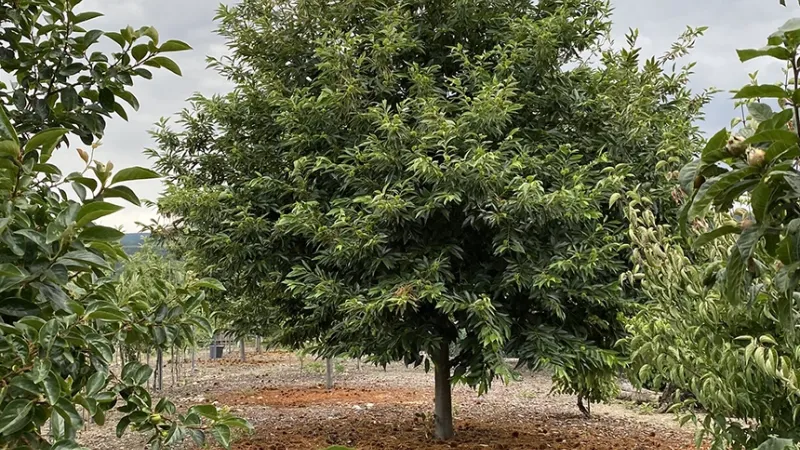
V posledných desaťročiach sme svedkami extrémneho poklesu produkcie jedlých gaštanov v dôsledku devastácie gaštanových sadov chorobami Phytophthora cinnamomi a Cryphonectria parasitica. Európske gaštanové výsadby sa nachádzajú v nadmorských výškach od 200 do 1 000 metrov, kde by ich iná poľnohospodárska produkcia len ťažko dokázala nahradiť. Produkcia gaštanov tu zohráva dôležitú úlohu. Hospodárenie na pôdach vysadených gaštanmi je náročné. Ak zaniknú gaštanové sady, dôsledkom bude koniec akejkoľvek možnosti poľnohospodárskeho rozvoja so všetkými hospodárskymi, sociálnymi a environmentálnymi následkami. Preto sa v Európe v posledných rokoch rozbehli ambiciózne programy výsadby nových gaštanových plantáží.
Rodinné farmy
Vo veľkej väčšine prípadov je produkcia gaštanov založená na tradičných rodinných farmách. Odchod obyvateľov z vidieka v týchto na život náročných oblastiach vedie dodnes k opúšťaniu gaštanových sadov. Ak by bol program obnovy úspešný, určite by prispel k zastaveniu devastácie vidieckych komunít po celej Európe. Obnova európskych gaštanových sadov si vyžaduje komplexný prístup, ktorý zahŕňa nielen výsadbu nových stromov, ale aj zavedenie pestovateľských postupov na zabezpečenie ich dlhovekosti. To sa dá dosiahnuť len ďalšími investíciami do výskumu zameraného na šľachtenie odrôd gaštanov odolných voči chorobám a zlepšenie zdravia pôdy prostredníctvom metód ekologického poľnohospodárstva.
Na revitalizáciu existujúcich sadov a podporu zakladania nových sadov je nevyhnutný kvalitný rastlinný materiál.
Jedným z účinných spôsobov obnovy gaštanových sadov je vytvorenie komplexného plantážneho programu, ktorého cieľom je nahradiť stratené stromy v existujúcich výsadbách rezistentnými hybridmi gaštanov. V snahe získať vhodné odolné kultivary gaštanov inicioval v roku 1956 francúzsky Národný inštitút poľnohospodárskeho výskumu (INRA) program medzidruhovej hybridizácie s využitím japonského gaštana - Castanea crenata a európskeho gaštana - Castanea sativa. Cieľom tohto inovatívneho programu bolo vytvoriť nové hybridné odrody so zlepšenými znakmi a vlastnosťami, ale najmä s odolnosťou voči pôdnemu patogénu Phytophtora cinnamomi spôsobujúcemu koreňovú hnilobu. Japonské gaštany sú odolnejšie voči fytoftóre, ale sú menej vhodné ako podpníky, pretože sú náchylné na poškodenie chladom a majú menší priemer kmeňa ako silnejší Castanea sativa. Ich plody sú síce veľké, ale ich chuťové vlastnosti výrazne zaostávajú za európskymi gaštanmi.
Tento program spočiatku využíval prirodzené hybridy japonského a európskeho gaštanu, to znamená hybridy, ktoré vznikli voľným opelením medzi jednotlivými stromami. Výsledkom bol vznik kultivarov Bournette a Précoce Migoule odolných voči fytoftórovej hnilobe koreňov a vhodných na produkciu plodov. Okrem toho vznikli kultivary Marsol a Maraval odporúčané ako podpníky. Kultivar Marigoule, ďalší prirodzený hybrid z tohto šľachtiteľského programu, bol najprv určený na zalesňovanie, potom sa používal ako podpník a v súčasnosti sa odporúča na produkciu gaštanov.
Šľachtiteľský program sa potom zameral na kontrolované hybridizácie, to znamená že materský a otcovský komponent sa umiestnili do izolátora - skleníka. Tu prebehlo kontrolované opelenie, čo umožnilo vyšľachtenie kultivarov ako Bouche de Bétizac, ktorý je odolný voči fytoftórovej hnilobe koreňov - Phytophthora cinnamomi, tolerantný voči rakovine kôry - Cryphonectria parasitica a nedávno sa zistilo, že je odolný aj voči napadnutiu škodcom Dryocosmus kuriphilus. Súbežne boli vytvorené aj nové podpníky odolné voči fytoftórovej hnilobe koreňov - Maridonne a Marlhac.
Presun programu šľachtenia do Bordeaux
V roku 1971 bol šľachtiteľský program umiestnený do INRA Bordeaux. Tu sa nasledujúce roky vykonávala šľachtiteľská práca, ktorá poskytla hybridy viac podobné európskym druhom a ktoré sú teraz základom francúzskej produkcie gaštanov.
Šľachtiteľským cieľom pri vývoji podpníkov bolo:
- zlepšiť toleranciu voči fytoftórovej hnilobe koreňov v porovnaní s európskym gaštanom
- zabezpečiť strednú až vysokú vitalita rastu a adaptáciu na francúzske podnebie
- umožniť ľahké rozmnožovanie oddelkami
Šľachtiteľským cieľom pri vývoji kultivarov na produkciu gaštanov bolo:
- zlepšiť veľkosť gaštanov v porovnaní s európskym gaštanom
- produkovať plody, ktoré sa ľahko vylupujú
- zlepšiť kvalitu gaštanov v porovnaní s japonským rodičom
Informácie, propagácia, marketing...
Okrem poskytovania výsadbového materiálu je dôležité neustále vzdelávať majiteľov gaštanových sadov, aby sa zabezpečilo, že majú potrebné vedomosti a zručnosti potrebné na správnu starostlivosť o svoje gaštany. To môže zahŕňať organizáciu seminárov o technikách rezu, ochrane proti škodcom a chorobám a ekologických poľnohospodárskych postupoch.
Premyslená propagácia konzumácie gaštanov a gaštanových výrobkov môže pomôcť vytvoriť dopyt po tejto plodine a motivovať poľnohospodárov k investovaniu do svojich sadov. To sa dá dosiahnuť prostredníctvom marketingových kampaní, spolupráce s kuchármi a výrobcami potravín a účasti na miestnych podujatiach zameraných na jedlo a farmárskych trhoch.
Kombináciou osvedčených postupov hospodárenia s ambicióznym pestovateľským programom môžeme pracovať na zastavení úpadku európskych gaštanových sadov a zabezpečiť udržateľnosť tejto cennej plodiny. Je nevyhnutné, aby sme konali teraz a zachovali tento úžasný strom a jeho lahodné plody pre budúce generácie.












